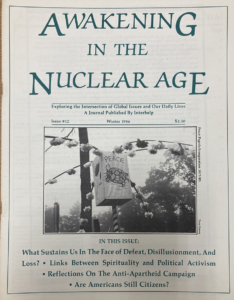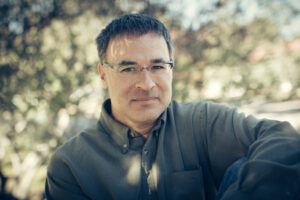By Marc Decitre
This article is a condensed and reworked transcript of the first portion of a talk given at the Gaian Gathering: “A Brief History of the Work that Reconnects”. The talk drew from research conducted for a master’s thesis, based on interviews with key protagonists as well as written archival resources–books, articles, and journals produced by various branches of the Interhelp Network (1). While the talk focuses on the entire period, from the late 1970s to the present, this article will limit itself to the early years: the emergence of “Despair and Empowerment Work” within the nuclear freeze campaign in the early 1980s.
The cauldron: 1970s catastrophist environmentalism
Nothing short of a complete overhaul of modes of life, especially in the industrialized West, would be necessary to turn the tide
It is within this context that the first root experiences took form. As Joanna Macy retells it, her environmental awakening arose in 1977, when she attended a conference at the Boston Colosseum on threats to the biosphere. The barrage of bad news provoked a visceral understanding that it was possible to destroy this world, plunging her into a “dark night of the soul”. In ’78, while leading a seminar at the University of Notre Dame on the prospect for human survival, she asked the different participants to introduce themselves with an image or an experience of the moments where they felt the planetary crisis impinged on their own life. That sharing transformed the energy of approaching such heavy material. And out of that came the first article that outlined her basic insights on the idea of “Despair Work”.
This trajectory resonates with that of another early Interhelper: Chellis Glendinning. After the Three Mile Island accident in 1979, Glendinning had a similar “dark night of the soul”, taking the incident as a symptom of the apocalyptic times that they were living in. Invited to a psychologists’ conference, she offered the despair ritual, which is still in Coming Back to Life, and had a similar experience of transmuting the sense of isolation and helplessness into connection and solidarity.
These experiences mirror each other: the moment of revelation and dread, and the lifting of the veil. Then the dark night of the soul, the despair, which is both a function of the enormity of threats that are apprehended and the absence of the social space in which to reckon with that enormity.
These early explorations, however, were not enough to trigger the development of an entire body of practice. After writing her first article, Joanna Macy was still set on pursuing an academic trajectory and certainly not imagining pursuing her insights any further. The catalyst for that was the “Euromissile Crisis” and the accompanying peace movement that arose to counter it.
The Euromissile Crisis and the Nuclear Freeze Campaign
In 1977 the Soviet Union developed a new type of missile (SS20) that threatened Western Europe. NATO responded two years later by installing another generation of missiles, Pershing II cruise missiles: a huge escalation because it made a first-strike attack a possibility. It meant that if one or the other side struck, it only gave the other a few minutes to respond with full force. In the wake of this new balance of power, people were living with the fear that total nuclear war was not only possible but probably imminent (and Reagan’s inauguration in ’81, who came in with very saber-rattling language, talking about a winnable nuclear war, only exacerbated these fears).
In response a mass movement took form: the Campaign for Nuclear Disarmament, which demanded a freeze on the production of nuclear weapons and for those new missiles to be taken out of Western Europe. The early Interhelpers were part of that movement, part of a wider web within the environmental, peace, and feminist movements, which “stood at the intersection of the political, the spiritual, and the psychological” (to use Sarah Pirtle’s expression). In a context of heightened urgency, they put a pause on whatever they were doing in an all-hands-on-deck emergency mode, to come together and come up with these transformative practices.
One of the elders was Joseph Havens, a 60-year-old Quaker who had studied depth psychology and humanistic psychology with Carl Rogers.
Sarah Pirtle was working for the Traprock Peace Center in Massachusetts at the time of the campaign. She had grown up during the Civil Rights Movement and had participated in and led early consciousness-raising groups in Cleveland, Ohio. She wrote songs for the ecofeminist movement, being present for most of its founding moments: the Women and Life on Earth Eco-feminist conference Spring Equinox 1980, the Pentagon Action, and the Seneca Peace Encampments (see this article for more details on the ecofeminist wing of the peace movement). She marked the culture of Interhelp by the particular emphasis given to music and the importance of the spiritual dimension, as well as fostering an atmosphere of kindness and friendliness to all aspects of organizing. She later devoted significant time to working with young people through peace camps and books (including a novel about a teen-led peace group, which she just re-edited).
Fran Peavey … was the one who pushed to create a network, taking on a lot of the backstage organizational work, giving it its nonhierarchical form, inspired by the Movement for a New Society.
Chellis Glendinning, a psychologist deeply involved in the feminist and ecofeminist movement…translated many of the tools from consciousness-raising groups into Despair and Empowerment Work.
The founding of Interhelp
The first Interhelp gathering was held in October 1981 in Northern California. Joanna Macy’s article, “Despair and Empowerment in the Nuclear Age” had engendered more response than any other in New Age Magazine and helped summon people to the gathering. Other presenters at the gathering included Barbara Hazard and Kevin McVeigh who offered how to incorporate co-counselling methods. Kevin’s article “No feeling, no healing” described their way of addressing nuclear apathy. Fran Peavey and Charlie Veron presented their work called Humpty Dumpty and shared their Atomic Comics show.
In May 1982 Joanna Macy and Joe Havens invited Kevin McVeigh and Sarah Pirtle to assist them at the first training for trainers (which was held in Temenos, the retreat center in Western Massachusetts founded by Joe and Teresina Havens). This began a practice of linking people across the country by holding a National Interhelp gathering on the west coast one year followed by an east coast location the next year.
 Interhelp acted as a seed ground for people to launch projects and deepen their approach to preventing nuclear war. Kevin McVeigh became the first National Coordinator of Interhelp in September 1983 when he opened a national office in Northampton MA. In addition to monthly newsletters, he coordinated national and regional gatherings, as well as arranging and co-leading trainings. His gift was both writing and giving individual attention to everyone who contacted the office; he was responsible for helping individuals find a way to plug into the network. At the same time, Rosa Lane started the quarterly journal. The Interhelp mission statement stated:
Interhelp acted as a seed ground for people to launch projects and deepen their approach to preventing nuclear war. Kevin McVeigh became the first National Coordinator of Interhelp in September 1983 when he opened a national office in Northampton MA. In addition to monthly newsletters, he coordinated national and regional gatherings, as well as arranging and co-leading trainings. His gift was both writing and giving individual attention to everyone who contacted the office; he was responsible for helping individuals find a way to plug into the network. At the same time, Rosa Lane started the quarterly journal. The Interhelp mission statement stated:
Interhelp is a nonpartisan network whose purpose is to provide people the opportunity to experience and share with others their deepest responses to the dangers which threaten our planet–be they dangers of nuclear holocaust, environmental deterioration, or human oppression. We aim to enable people to know the power that comes from their interconnectedness with all life and to move beyond powerlessness and numbness into action.
This was the key stake, the key question that guided their work: how to reclaim one’s power to act in the face of such overwhelming threats.
Psychic Numbing, the Civil Defense Program, and Interhelp’s Responses
The Civil Defense Program…was…one of the biggest propaganda campaigns in US history, where the State Department allied with…mass media to create “preparedness” towards the threat of nuclear war.
To understand why this psychological dimension seemed both so important and so neglected, we need to look at the longer history of the Civil Defense Program. This was essentially one of the biggest propaganda campaigns in US history, where the State Department allied with different forms of mass media to create “preparedness” towards the threat of nuclear war. Between 1953 and 1963, the program was deployed in every single school, church, and community in America, theatricalizing the possibility of nuclear warfare, with films like Operation Q, which showed a fake town being destroyed by a nuclear bomb. The idea was to calibrate emotional reactions to nuclear war, reconfiguring the image of nuclear ruin as a site to demonstrate the American spirit of preparedness and overcoming the harsh conditions of the frontier. (See “Survival is your Business” by Joseph Masco.) You have to think about what it means for a country to create a mass circulation of images of its own ruin. At the time it reached 150 million people over 10 years, making the threat of nuclear war percolate into the very intimacy of daily life, while at the same time creating a total taboo on discussing the omnipresence of this threat and the emotional toll it took.
These tropes were initially remobilized by peace groups working for a Nuclear Freeze. The British movie “War Game” depicted the horror of nuclear war, showing people a reality that no one would want to live through. The underlying idea was that if people were more informed, they’d mobilize. But these films often had the opposite effect, relying on images of nuclear ruin, without regard for their psychological toll.
The nuclear threat was so overwhelming that people just shut down.
And so the specific practices got developed in this practical process of trial and error, responding to calls from churches, universities, communities who were organizing for the nuclear freeze campaign. Sometimes it would be very simple open questions during an evening forum: “When I think about the threat of nuclear war, I feel…” and people would open up. At Traprock Peace Center, Sarah Pirtle led Interhelp-style conversations in pairs when she was asked to accompany “War Game.” The idea was to antidote it. She wrote and distributed a pamphlet to teach other centers this option. When the movie “The Day after Tomorrow” was slated to be shown nationally, Interhelper Wendy Roberts from California put aside her therapy practice to respond to the upcoming movie by working full-time on what she dubbed “The Day Before.” Wendy organized Interhelp members across the country to lead programs the night before the TV showing. This is an example of what Kevin McVeigh describes: “Interhelp gave birth to a wide range of endeavors primarily led by educators, therapists and people from religious communities.”
So the Interhelpers participated in this surge of invention to come up with these practices under the incredible pressure of the Euromissile Crisis, guided by a desire to have a balance between heart and mind, to weave in emotion, singing, dance and art with more politically oriented strategy and action. Because these practices were serving a specific movement, action was woven in organically, the “empowerment phase” sometimes involving a simple action like canvassing for the freeze, or creating long-term activist support groups.
As the wider peace movement began to wane, members split off into their own direction, and the practices…took on a life of their own as they circulated in other contexts.
_______
(1) This version received generous reviews from Sarah Pirtle and former National Coordinator Kevin McVeigh. An unexplored source of material rests in the twenty boxes of Interhelp newsletters, journals, correspondence and thematic files such as “Nuclear Arms race” given by Kevin to the Dubois Collection at the University of Massachusetts in Amherst under the “Famous Long Ago” section. Kevin McVeigh also did an interview on history for the collection.
This article is an edited transcription of a talk given at the Gaian Gathering of the Work That Reconnects Network in November 2023. A video of the full talk is available on the WTR Network website here.
__________________________________

Marc Decitre is a Brussels-based playwright, academic, and activist, who situates his work at the intersection of social ecology and eco-spirituality. He is currently working on a play that revisits the Tower of Babel story through an ecological lens.


 Interhelp acted as a seed ground for people to launch projects and deepen their approach to preventing nuclear war. Kevin McVeigh became the first National Coordinator of Interhelp in September 1983 when he opened a national office in Northampton MA. In addition to monthly newsletters, he coordinated national and regional gatherings, as well as arranging and co-leading trainings. His gift was both writing and giving individual attention to everyone who contacted the office; he was responsible for helping individuals find a way to plug into the network. At the same time, Rosa Lane started the quarterly journal. The Interhelp mission statement stated:
Interhelp acted as a seed ground for people to launch projects and deepen their approach to preventing nuclear war. Kevin McVeigh became the first National Coordinator of Interhelp in September 1983 when he opened a national office in Northampton MA. In addition to monthly newsletters, he coordinated national and regional gatherings, as well as arranging and co-leading trainings. His gift was both writing and giving individual attention to everyone who contacted the office; he was responsible for helping individuals find a way to plug into the network. At the same time, Rosa Lane started the quarterly journal. The Interhelp mission statement stated:



 Strands of Infinity: Poetry to Reconnect
Strands of Infinity: Poetry to Reconnect
 Silvia Di Blasio works supporting various organizations and projects including the
Silvia Di Blasio works supporting various organizations and projects including the 

